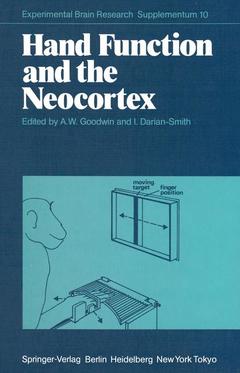Description
Hand Function and the Neocortex, Softcover reprint of the original 1st ed. 1985
Experimental Brain Research Series, Vol. 10
Coordinators: Goodwin A.W., Darian-Smith I.
Language: English
Publication date: 10-2013
316 p. · 17x24.4 cm · Paperback
316 p. · 17x24.4 cm · Paperback
Description
/li>Contents
/li>
To watch a curious young macaque explore and manipulate his immediate surroundings must surely delight and amaze us all. The monkey selects a particular objectfor scrutiny, reaches out and grasps it, handles it delicately with the fingers or more forcibly with the hand, scans the various surfaces with the fin ger pads, and finally identifies it. If we compare this monkey's adroitness and discriminative capacities with our own, at once we have a concise statement of important biological similarities and differences among primates. While there are species diffe rences in the functional anatomy of the hand, in tactile sensibi lity, and in the control of hand movements, these are relatively minor. The real difference in the dexterity of the two species relates to the complexity of the task that is executed: no monkey, and for that matter only one man in a century, paints a Guernica, although an astute investigator can readily teach the monkey to flourish a brush and paint a few strokes. The goal of the symposium, of which this book is a summary, was to examine current knowledge of those cortical mecha nisms that determine the sensorimotor functions of the hand that are common to man and the monkey - mechanisms accessible to analysis by recording the responses of single cortical neurons while the monkey explores and manipulates his surroundings.
Significance of Single or Multiple Cortical Areas for Tactile Discrimination in Primates.- Scanning a Textured Surface with the Fingers: Events in Sensorimotor Cortex.- Functional Surface Integration, Submodality Convergence, and Tactile Feature Detection in Area 2 of the Monkey Somatosensory Cortex.- Sensorimotor Cortex Responses to Vibrotactile Stimuli During Initiation and Execution of Hand Movement.- Tactual Roughness Perception in Human: A Psychophysical Assessment of the Role of Vibration.- Somatosensory Detection in Man.- Coordinated Control Programs for Movements of the Hand.- Transcortical Reflexes: Their Properties and Functional Significance.- Small Hand Muscles in Precision Grip: A Corticospinal Prerogative?.- Relations Between Two-Dimensional Arm Movements and Single-Cell Discharge in Motor Cortex and Area 5: Movement Direction Versus Movement End Point.- Differences of Neuronal Responses in Two Cortical Motor Areas in Primates.- Activity of Areas 4 and 7 Neurons During Movements Triggered by Visual, Auditory, and Somesthetic Stimuli in the Monkey: Movement-Related Versus Stimulus-Related Responses.- Motor and Sensory Properties of Primate Corticomotoneuronal Cells.- Effects of Lesions of the Corpus Callosum on Tactile Cross-Localization.- Activity of Dentate and Interpositus Neurons During Maintained Isometric Prehension.- Topographical Aspects of Cerebral Cortex and Dentate Nucleus in the Control of Hand Movements.- Compensatory Motor Function of the Somatosensory Cortex in the Monkey Following Cooling of the Motor Cortex and Cerebellectomy.- Activity of Neurons in the Prefrontal Cortex During Visually and Pain-Induced Hand Movements in Monkeys.- Thalamocortical Organization in the Raccoon: Comparison with the Primate.
© 2024 LAVOISIER S.A.S.





